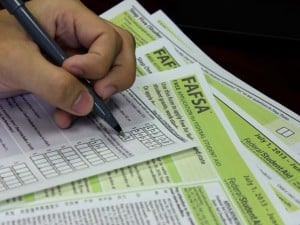Completing the Free Application for Federal Student Aid (FAFSA) gives you access to different types of financial aid, including grants, scholarships, and loans.
However, making a mistake on your FAFSA application can cost you money, especially if you require need-based aid to attend. Unfortunately, these errors are not uncommon. Every year, hundreds of students lose out on their entitled financial aid because they made common FAFSA mistakes with their applications.
The financial aid application is just as important as your college applications. Filling out the FAFSA correctly is a crucial step to ensuring that you get the best offers possible. Here are some common FAFSA mistakes to avoid, and steps you can take if you realized you made an error after you hit “submit.”
Common FAFSA Mistakes to Avoid
These are some of the more common FAFSA mistakes to avoid. Students make these common mistakes on their applications every year:
1. Typos
Of course, you can make typos on just about every document, but typing in your name, social security number, or income incorrectly can impact your application. Review your application completely to double check for any of these typos.

2. Failing to Answer All of the Questions Completely and Correctly
Skipping over questions or missing them by accident can absolutely impact the results of your FAFSA. Students and their parents or guardians need to answer every single question to the best of their ability. No questions should be left blank.
Answering a question with incorrect or inaccurate information, too, can have disastrous consequences. If it was found to be done on purpose, the student can be fined up to $20,000 and may be sent to prison.
3. Failing to Update Details
FAFSA saves your information so you can easily submit future applications. However, that doesn’t mean you can set it and forget it.
Your application should also be checked to ensure it’s updated properly every year, especially if your income or contact details have changed in the past year. Information should also be updated after your family completes their tax returns.
4. Not Signing the Document
The FAFSA requires you to enter your FAFSA pin (also known as an electronic signature), sign the form, and date it. If you don’t do this, your form will only be partially processed. You will then be asked to complete a Student Aid Report. If you don’t submit your signature, you won’t receive any financial assistance or offers.
5. Submitting the Application After the Deadline
The deadline for the FAFSA application is quite generous. The application becomes available on October 1st for the following school year. The deadline will then be June 30th of that completed school year. So, for 2022-2023, the application became available on October 1st, 2021 and will be available until June 30th, 2023.
Colleges, also, have their own deadlines for the application. This can usually be found on the school’s financial aid department website. Submitting your FAFSA after this date could take you out of the running for institutional grants.
Even with a long federal deadline for the FAFSA, students still manage to miss it. However, there are resources available and it’s recommended that you still submit your FAFSA as soon as possible and talk to your college’s financial aid department to get it straightened out if there is recourse available.
6. Submitting the Application Late
Although the FAFSA has a very long deadline as mentioned, the longer you wait, the less likely you are to get offered substantial financial assistance beyond federal loans. Colleges can and will run out of financial aid packages for their students, and you could mean you receive no institutional grant offers from the school.
It’s highly recommended that you complete your FAFSA as soon as possible after October 1st. Gathering your necessary information in September, like your parents’ financial details, can ensure you’re ready to go on that day.
7. Only Completing the FAFSA Before the First Year of College
Many students and their families think they only need to complete the FAFSA once, either because that’s how they believe the system works or because they weren’t offered anything the first year besides loans.
However, students should complete the FAFSA every single year of their college experience. If you are receiving institutional grants and federal aid that are based on this application, you could lose out on the offers if you fail to complete it each year.
And even if you didn’t receive any offers the first year, colleges do often change their grant requirements and offerings. A school could have a new aid package that wasn’t offered your first year but is available during your junior year. Or they could have different income criteria for their existing packages. This is especially the case if your income or financial situation has changed at all during your education.
It sometimes pays off to complete your FAFSA, even if you think you aren’t eligible for anything.
What Do You Do if You’ve Made a Mistake on Your FAFSA?
While you should absolutely review your FAFSA before you submit it, mistakes happen. You might notice right away or you could receive your Student Aid Report and realize there’s a problem. If you’ve found you’ve made an error, there are steps to rectify it!
First, for many common FAFSA mistakes, you can simply edit your FAFSA application. After you submit it, there is an application process that takes about three to five days. During this time, your details will be locked. After it is completed, you can go in and change the appropriate information.
However, there are some exceptions to this, and some changes may require you to contact your school’s financial aid office for further direction. This includes your marital status, current income, and extraordinary circumstances regarding financial status and income. Social security numbers cannot be easily changed, either. If you entered in the wrong SSN, it is recommended that you completely start a new application from scratch. You can submit your correct SSN on the Student Aid Report, but it has to be submitted by mail and can take a while, so the new application method is faster.
It’s best to avoid errors on your FAFSA the first time around to avoid stress and headaches. Although most mistakes can be easily rectified if noticed ahead of time, if they’re not found, you could miss out on serious cash. It’s always recommended that you read your application a few times for typos and errors before you hit submit.
Affording college can be a headache in itself, even when FAFSA mistakes are avoided. If you want to make the experience and cost less stressful, we suggest using College Raptor’s Student Loan Finder and Scholarship Search tool!
| Lender | Rates (APR) | Eligibility | |
|---|---|---|---|
 |
5.34%-15.96%* Variable
3.99%-15.61%* Fixed
|
Undergraduate and Graduate
|
VISIT CITIZENS |
 |
4.92% - 15.08% Variable
3.99% - 15.49% Fixed
|
Undergraduate and Graduate
|
VISIT SALLIE MAE |
 |
4.50% - 17.99% Variable
3.49% - 17.99% Fixed
|
Undergraduate and Graduate
|
VISIT CREDIBLE |
 |
6.00% - 13.75% Variable
3.99% - 13.75% Fixed
|
Undergraduate and Graduate
|
VISIT LENDKEY |
 |
5.50% - 14.56% Variable
3.69% - 14.41% Fixed
|
Undergraduate and Graduate
|
VISIT ASCENT |
 |
3.70% - 8.75% Fixed
|
Undergraduate and Graduate
|
VISIT ISL |
 |
4.99% - 16.85% Variable
3.47% - 16.49% Fixed
|
Undergraduate and Graduate
|
VISIT EARNEST |
 |
5.00% - 14.22% Variable
3.69% - 14.22% Fixed
|
Undergraduate and Graduate
|
VISIT ELFI |





